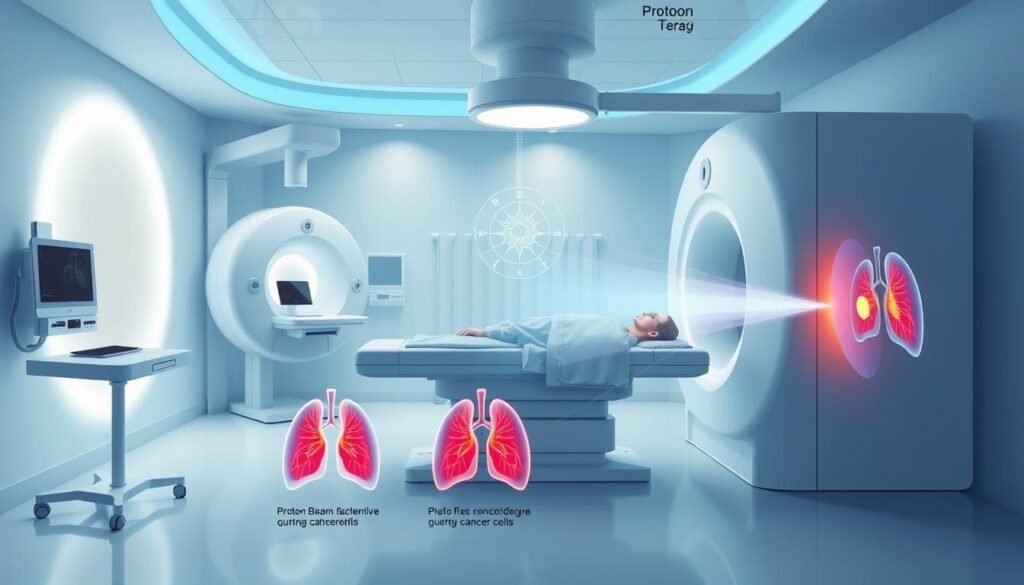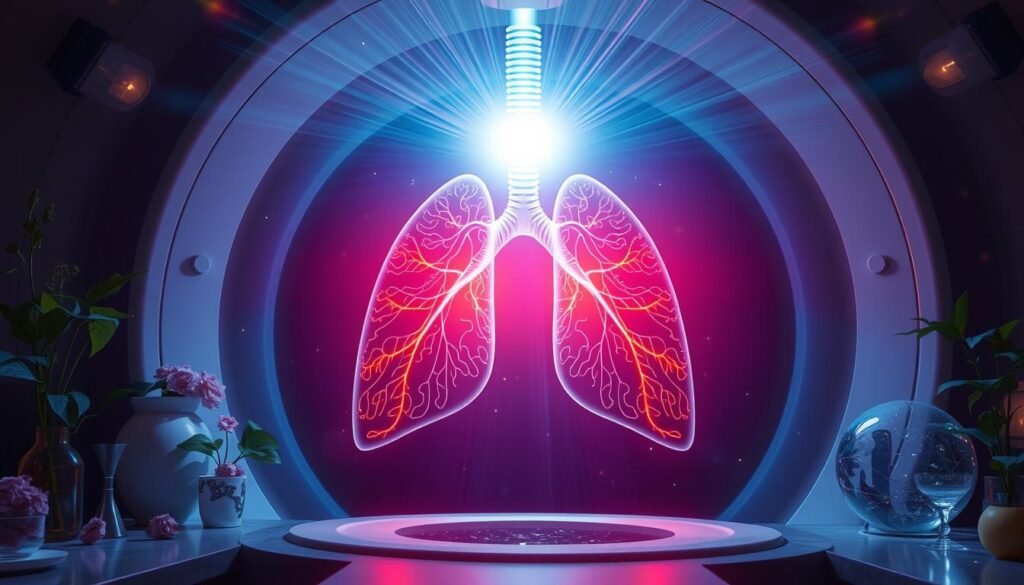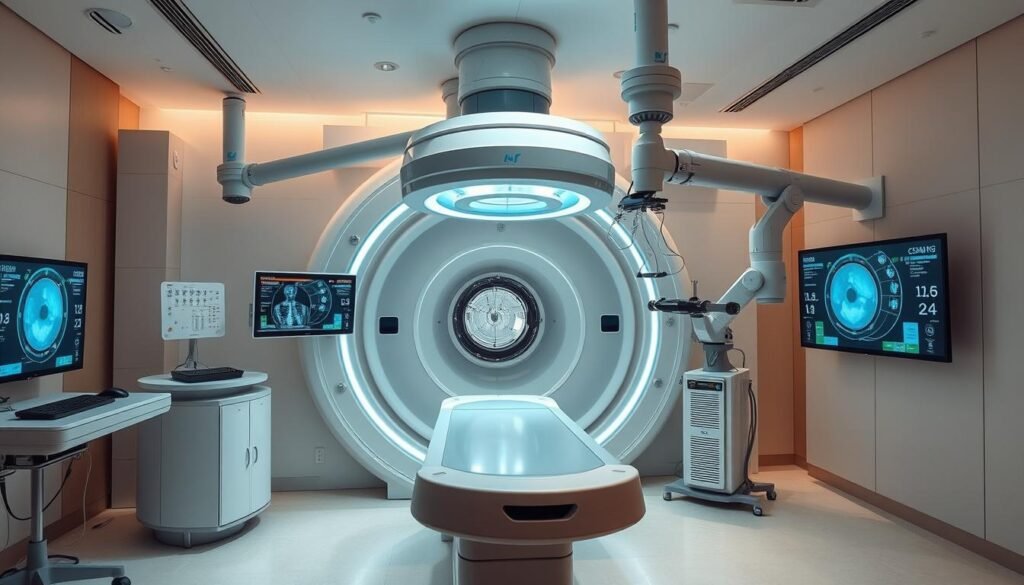Lung cancer is the top cause of cancer deaths in the US. It takes more lives than breast, prostate, and colorectal cancers combined. This alarming fact shows how crucial it is to find new treatments such as proton therapy. Proton therapy is an advanced treatment that targets tumors with precision. It spares the healthy tissue around them. This is vital for people with lung cancer who often face tough outcomes.
The MD Anderson Proton Therapy Center is a leader in proton therapy, focusing on lung cancer care. It reduces harmful radiation to vital organs like the heart and esophagus. This means patients not only get better treatments but also enjoy a higher quality of life. To see how proton therapy helps lung cancer patients in detail, visit the MD Anderson Proton Therapy Center’s site.
Key Takeaways
- Proton therapy lessens radiation to healthy tissue, meaning fewer side effects.
- This precise treatment could help improve lung cancer survival rates.
- Patients have shorter treatments with less sessions than traditional radiation.
- Proton therapy uses top methods for accurate tumor targeting.
- It has shown to cause fewer complications like pneumonitis and esophagitis.
- For those who can’t have surgery due to cancer stage, proton therapy might work.
Introduction to Lung Cancer and Its Challenges
Lung cancer is the top cancer killer in North America for both men and women. The stats are startling, with 2.09 million new cases worldwide in 2018. This makes up 12.3% of all cancer diagnoses. That year, 1.76 million people died from lung cancer. These numbers highlight the urgent need to tackle lung cancer challenges. Most patients find out they have it when it’s already advanced.
Lung cancer is tough to treat because the tumors are close to the heart and esophagus. This makes treatment complex. Now, there are new therapies like proton therapy aiming to boost survival rates. But, the five-year survival rate for lung cancer is still low at 28.2%. It shows how serious this disease is.
Traditional treatment methods don’t always work well. So, experts are looking for ways to better target radiation. A big step forward is proton therapy. It helps avoid damage to healthy tissues and targets the tumor better. These improvements are key in fighting the hurdles faced by those with lung cancer.
Understanding Proton Therapy for Lung Cancer Treatment
Proton therapy is a cutting-edge way to fight cancer. It uses high-energy protons to attack cancer cells very precisely. This proton therapy overview shows it does less harm to healthy tissues nearby. That makes it a standout option for treating lung cancer. Traditional X-ray radiation hits a wider area. But proton therapy focuses only on the tumor. This makes the treatment safer and more effective.
Proton therapy isn’t available everywhere yet. But more centers for it are opening in the United States. This growth shows that its value is being recognized more widely. For instance, the Maryland Proton Treatment Center treats different lung cancers. They handle varieties like non-small cell lung cancer and small cell lung cancer.
One big plus of proton therapy is fewer side effects. Traditional radiation can cause tiredness, skin problems, and issues with important organs. Proton therapy greatly reduces these problems. It’s so accurate that it keeps the heart and esophagus safe from radiation. This makes it a great choice for people with lung cancer.
Comparing proton therapy to conventional X-ray therapy is in early stages. But, the signs are good that it makes life better for patients. It works well against lung tumors and protects nearby tissues. This cuts down on problems caused by treatment.

| Characteristic | Proton Therapy | X-Ray Radiation Therapy |
|---|---|---|
| Treatment Precision | High accuracy targeting | Broad radiation exposure |
| Side Effects | Reduced incidence | Higher risk of complications |
| Availability | Limited but growing | Widely available |
| Common Uses | Lung cancer and others | Various cancer types |
Proton therapy represents progress in cancer treatment. It aims to be very effective while also making treatment easier on patients. As its use grows, it brings hope to those with lung cancer. They are looking for better treatment options.
Benefits of Proton Therapy for Lung Cancer Patients
Proton therapy offers great benefits for those fighting lung cancer. It targets cancer cells while protecting healthy tissue. This makes it a great choice for patients. It does more than just target the tumor. It also focuses on improving the patient’s overall wellbeing.
Reduced Side Effects Compared to Traditional Methods
Proton therapy lowers the risk of harming healthy tissue with radiation. Traditional methods can affect nearby organs and lead to more side effects. By using proton therapy, problems like pneumonitis and esophagitis are much less common. Reduced side effects mean patients have a healthier recovery.
Precision in Targeting Tumors
Proton therapy uses positively charged particles for precise targeting. It allows for higher doses of radiation right to the tumor, while saving healthy tissue. This approach improves patient outcomes by focusing intensely on the tumor. The technology behind proton therapy offers unique benefits because of its accuracy.
Improved Quality of Life During Treatment
Choosing proton therapy can lead to an improved quality of life during and after treatment. Patients report fewer side effects, making the therapy easier to handle. This is important for those with other health issues or past cancer treatments. For more on how proton therapy can help, visit Lung Cancer Treatment with Proton Therapy.
| Feature | Proton Therapy | X-ray Radiation Therapy |
|---|---|---|
| Radiation Precision | Highly precise targeting, minimizing damage to healthy tissue | Risk of damaging surrounding healthy tissues |
| Side Effects | Reduced side effects, lower risk of complications | Higher incidence of complications, including pneumonitis |
| Treatment Efficacy | Higher radiation doses directly to tumors | Lower doses to tumors, affecting efficacy |
| Quality of Life | Improved quality of life during treatment | Potentially reduced quality of life due to side effects |
How Proton Therapy Works and Its Unique Advantages
Understanding proton therapy is key to seeing its benefits for lung cancer. It uses protons, not X-rays, for treatment. This lets doctors target the tumor precisely without harming nearby healthy tissue. This is especially good for lung cancer, where tumors are close to important areas.
The Bragg Peak and Its Importance
The Bragg Peak plays a big role in proton therapy’s success. Protons release most energy right at the tumor, sparing healthy tissue. This boosts treatment success and cuts down on side effects. It helps patients face fewer issues, leading to a better life quality.
Comparison with Conventional Radiation Therapy
Proton therapy and regular radiation are quite different. Normal X-ray therapy can affect healthy tissues around the tumor, causing more side effects. But proton therapy is more precise. It lowers the risk of harming vital organs. This means lung cancer patients have a better chance at recovery and face fewer additional health problems.

Evidence Supporting Enhanced Lung Cancer Survival Rates
Lung cancer treatment has seen real progress, especially with proton therapy. This type of therapy shows great promise in increasing survival rates for lung cancer. It’s most helpful for patients whose cancer can’t be removed with surgery and is often used along with chemotherapy.
Studies Highlighting Survival Improvements
Studies show proton therapy is gentler than traditional radiation and leads to better results. Key findings include:
- The overall 5-year survival rates for lung cancer types NSCLC and SCLC are between 15% and 25%.
- Only 12% of patients getting proton therapy with chemotherapy had severe side effects. This is low compared to 28% with regular X-ray therapy.
- Proton therapy showed a 46% cancer-free survival rate over three years. This is close to the 49% rate from standard treatments.
- People getting proton therapy had less decline in health and activity levels.
Success Stories from Proton Therapy Patients
Many patients share positive stories about proton therapy. They talk about:
- Having fewer harsh side effects from treatment.
- Being able to keep up with daily life better.
- Feeling hopeful due to good survival rates and treatment outcomes.
Future research may combine new strategies and higher doses of chemotherapy with proton therapy. The goal is to further raise survival rates for lung cancer while reducing side effects. This gives hope to those fighting this tough disease.
The Role of Advanced Techniques in Proton Therapy
Advanced techniques in proton therapy are changing the game for lung cancer treatment. They use Intensity-Modulated Proton Therapy (IMPT) and Pencil Beam Scanning (PBS). These methods improve how precisely we can target tumors while protecting nearby healthy tissues.
Intensity-Modulated Proton Therapy
Intensity-Modulated Proton Therapy, or IMPT, changes radiation doses in different tumor areas. It aims to maximize treatment effectiveness while protecting other organs. Thanks to this ability, IMPT offers better outcomes in lung and chest cancers, becoming a top choice in cancer treatment.
Pencil Beam Scanning Technology
Pencil Beam Scanning, or PBS, uses thin proton beams for increasing treatment accuracy. It’s great for treating complex tumors without harming important organs like the heart and lungs. Unlike older methods, PBS leads to lesser side effects. Research shows that PBS in proton therapy outperforms traditional photon-based methods, marking an advancement in cancer treatment.
By adopting these advanced proton therapy techniques, doctors can provide superior care and enhance lung cancer survival rates. Adding in good hydration practices boosts treatment effects and overall well-being. Learn more about hydration’s impact on lung cancer treatment in this detailed guide.

Eligibility for Proton Therapy in Lung Cancer Patients
The journey to see if a patient can get proton therapy is careful and unique. Not all lung cancer patients can get this cutting-edge therapy. It’s mostly for those with specific types of lung cancer, including those getting chemo.
Doctors look at many things before saying yes to proton therapy. What’s happened health-wise before is very important. Things like past radiation or breathing problems play a big part. They want to make sure the therapy fits the patient’s needs perfectly.
The check for eligibility includes a few steps:
- Figuring out the lung cancer’s type and stage
- Checking overall health and how well the lungs work
- Looking at past treatments and how well they worked
- Thinking about possible side effects
In the end, deciding if proton therapy is right comes down to a personal review. Working closely with doctors is key. They help make sure every important detail is looked at during this important time.
What to Expect During Proton Therapy Treatment
The journey through proton therapy is both structured and flexible. It aims to meet lung cancer patients’ unique needs. Understanding the treatment timeline helps patients feel more at ease during this critical part of their cancer care.
Typical Treatment Timeline
Proton therapy sessions are usually held five days a week. The length of treatment can vary, depending on the cancer’s stage and type. Patients might need between 5 and 35 sessions, tailored to their cases. This approach focuses on the tumor while protecting healthy tissue. For more details, visit how proton therapy works.
Patient Experience and Comfort Measures
A supportive environment improves the treatment experience. Comfort measures help lower anxiety and build resilience. Personalized care might include:
- Relaxation techniques to manage stress.
- Access to counseling for emotional support.
- Patient education to increase understanding and involvement.
- Comfortable waiting areas with amenities.
Focus on comfort and emotional well-being makes therapy easier. It helps reduce side effects like fatigue, improving patients’ quality of life. This holistic approach cares for both the physical and emotional needs of lung cancer patients.
| Aspect | Details |
|---|---|
| Treatment Frequency | Five days a week |
| Number of Sessions | 5 to 35 sessions |
| Common Side Effects | Fatigue, nausea, skin irritation, hair loss |
| Comfort Measures | Relaxation techniques, counseling, education, comfortable amenities |
Conclusion
Proton therapy is changing how we treat lung cancer. It makes patient care better with its special features. These features include fewer side effects and better accuracy in hitting tumors, which helps fight cancer.
Studies show proton therapy is effective. They report a 2-year survival rate of 45% for lung cancer patients. This is an encouraging sign for survival rates.
Advanced technology like intensity-modulated proton therapy is shaping the future of lung cancer care. This therapy helps patients by protecting healthy tissue nearby. It also improves their quality of life while they’re treated.
More clinics are offering this new therapy worldwide. As a result, lung cancer treatment is improving, helping more patients.
Making healthy choices, like not smoking, is key to lowering the risk of lung cancer. The website smoking and tobacco use offers advice to make better choices. This can reduce cancer risks.
Thanks to new research, the future looks brighter for treating this tough disease. There’s more hope for people affected by lung cancer today.